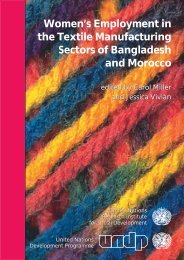Beyond Pragmatism: Appraising UN-Business Partnerships
Beyond Pragmatism: Appraising UN-Business Partnerships
Beyond Pragmatism: Appraising UN-Business Partnerships
You also want an ePaper? Increase the reach of your titles
YUMPU automatically turns print PDFs into web optimized ePapers that Google loves.
<strong>UN</strong>RISD PROGRAMME ON MARKETS, BUSINESS AND REGULATION<br />
PAPER NUMBER 1<br />
59) proposes: “we should try to analyse what effects local ownership can have in which<br />
situations and under what circumstances. Ultimately, these considerations should help<br />
determine what level of local ownership is most appropriate for what purpose. … And...one<br />
must develop criteria for assessing local ownership”.<br />
The notion of local ownership as applied to <strong>UN</strong>–BPs can mean very different things. For<br />
example, does it refer to initiatives in which local stakeholders participate, but which are<br />
essentially designed and promoted by external agents or international organizations? Or does it<br />
refer to partnerships initiated and driven by local agents (Steets 2006)? Such questions are<br />
relevant for the <strong>UN</strong> in general and, in particular, for brokering agencies like <strong>UN</strong>DP, <strong>UN</strong>ICEF<br />
and WHO that receive numerous “supply-driven” requests from Northern-based companies. In<br />
promoting the partnership approach, the <strong>UN</strong> makes frequent reference to its own catalytic role<br />
in promoting ideas or themes for particular partnerships. If partnerships essentially involve the<br />
transfer of knowledge, skills, technology or products, this may well imply a truncated<br />
interpretation of local ownership.<br />
Such tensions even affect showcase programmes promoting local ownership. Applying an<br />
expanded notion of local ownership that facilitates measurement, Steets conducted a survey of<br />
the partnership experiences related to the <strong>UN</strong>DP SEED Initiative. Promoted by <strong>UN</strong>DP, <strong>UN</strong>EP<br />
and IUCN, SEED aims to support nascent, locally driven, entrepreneurial partnerships<br />
involving various <strong>UN</strong> agencies, businesses, civil society organizations, public authorities and<br />
local communities. 77 The results of the study indicated that if the level of local ownership is said<br />
to depend upon how far and how meaningfully affected stakeholders are involved in the<br />
different stages of a development initiative, 78 then 63 per cent were found to be local. That is,<br />
local stakeholders took the initiative and remained the driving forces behind the initiatives. 79<br />
One-third were found to be “participatory international”, whereby international partners took<br />
the initiative and involved local stakeholders in a significant manner. In the remaining three per<br />
cent of partnerships, local stakeholders had no say (Steets 2006).<br />
More detailed research would be required to ascertain the degree of local ownership and<br />
success of other <strong>UN</strong>DP initiatives such as the GSB and the Equator Initiative, which is said to be<br />
a development strategy rooted in the knowledge and innovatory efforts of local peoples. 80 In<br />
this context, it is important to note the conclusion from Witte and Reinicke’s overview of <strong>UN</strong>–<br />
BPs (2005:45): “Bringing local ownership to partnerships is still a challenge. … Many<br />
partnerships, especially those that bring together the United Nations with multinational<br />
companies and transnational civil society, face shortcomings related to local ownership”. The<br />
issue of local ownership presents a rich research agenda for scholars concerned to dig deeper<br />
into this issue in relation to <strong>UN</strong>–BPs. The idea of local ownership in the context of <strong>UN</strong>–BPs<br />
needs a great deal more conceptual and operational clarification. At the same time, there is need<br />
for more thinking on how this ties in with country ownership. 81 As noted above, the two are not<br />
identical, and <strong>UN</strong>–BPs that can be defined as locally owned on the basis of clear criteria may<br />
not fit the aims and priorities of government development strategies and policies, and vice<br />
versa.<br />
77<br />
78<br />
79<br />
80<br />
81<br />
The support is provided by means of a biennial awards scheme, capacity-building activities and a research programme.<br />
Such stages included identifying the problems to be addressed, defining the goals and targets of a development initiative, setting and<br />
implementing concrete policies or activities, and evaluating them.<br />
See Steets (2006). For a more detailed discussion of the concept of local ownership, types of local ownership and the costs and<br />
benefits, in the context of the SEED partnerships, see Steets (2006:57–69).<br />
The Equator Initiative is not to be confused with the Equator Principles, which comprise a set of ethical principles to be adopted by<br />
financial institutions in their financing activities.<br />
The term “country ownership” often refers to planning and policy processes where national governments are supposed to be in the<br />
driving seat but consult with key development actors and organizations. The term is used in relation to the PRSPs promoted by the<br />
World Bank. PRSPs are supposed to be country owned in that they should be elaborated by governments on the basis of<br />
consultations with citizens groups and NGOs (hence the confusion with the term locally owned used in discussions of <strong>UN</strong>–BPs).<br />
34
















